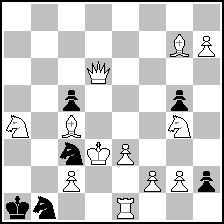
Website founded by
Milan Velimirović
in 2006
23:34 UTC


| |
MatPlus.Net  Forum Forum  General General  Selbstmatt Paradox Selbstmatt Paradox |
| |
|
|
|
|
You can only view this page!
| | | (1) Posted by Steven Dowd [Saturday, Mar 13, 2010 16:21] | Selbstmatt Paradox
In issues of the Schwalbe from late 1980s and 90s, I find that some authors presented what is called a "Selbstmatt Paradox" problem.
It is cited at least once as offering new potential.
I think I understand the idea, but just to be sure, would one of our experts explain it to me, and is this a testable condition with any of the current software programs?
I appreciate, as always, the sharing of expertise!!!
| | | (2) Posted by Steven Dowd [Sunday, Mar 14, 2010 21:19]; edited by Steven Dowd [10-03-14] |
I found my own answer at Chessworld, Hilmar Ebert's site. As I suspected, black must defend against any white mates in one. An interesting condition. I also found that the definition was set in a 2000 issue of Problemkiste, so I am seeing if I can get the relevant issue.
It would seem to encourage greater economy and perhaps the expression of some ideas that are difficult in the traditional selfmate.
| | | (3) Posted by Frank Richter [Tuesday, Mar 16, 2010 10:22] |
I remember, that this condition sounded interesting, but all examples were quite poor without any paradox and only few composers used "s# paradox". May be you'll find some new ideas?
| | | (4) Posted by Juraj Lörinc [Tuesday, Mar 16, 2010 13:02] |
In my view, this is a fairy condition like many other. It does not change the rules much, just sets the precedence of some black moves over other. Also, as with many other fairy conditions, early examples can be just demonstration-worthy and then it depends on whether the fairy element provokes ideas in wider set of problemists. My personal opinion is that it is slightly difficult to grasp for starting composing (I've tried myself), just like e.g. Anticirce that is sometimes highly counterintuitive. Yet, with some effort it might be very fruitful.
| | | (5) Posted by Steven Dowd [Friday, Mar 19, 2010 05:51] |
It makes some sense to me, although I have to read the article.
Does anyone know whether any of the solving programs support this condition? I could not find it in any of the solving programs I have, but I often overlook things......
| | | (6) Posted by Juraj Lörinc [Friday, Mar 19, 2010 11:49] |
If I remember correctly, WinChloe solves it, but I will have to check it at the other computer (where I have WinChloe installed).
| | | (7) Posted by Steven Dowd [Sunday, Mar 21, 2010 00:06] |
I tried it in Popeye, but only got a "stoerende Eingabe" message.
WinChloe probably does solve it, I will look there. It is just after Gustav, proofing any s# on other programs seems ridiculously slow.
| | | (8) Posted by Steven Dowd [Sunday, Mar 21, 2010 00:13] |
I don't know about finding too many new ideas, Frank, but I appreciate the vote of confidence. :)
It was interesting to finally read the article by Zander. I became interested in the condition proofing his s# in the PDB; I realize with the new s# revolution and so on, his types of problems are probably not the kind I should be learning from, but I really like his style. Mehrwertschach is another condition that he used that I found most interesting.
| | | (9) Posted by Juraj Lörinc [Sunday, Mar 21, 2010 00:53]; edited by Juraj Lörinc [10-03-21] |
I have just checked WinChloe, yes, it tests Paradox. I have also found this interesting work by late Helmut Zajic.
Helmut Zajic
1st Commendation harmonie 1999
 (= 12+6 ) (= 12+6 )
s#2
Paradox
In the initial position, White threats Bxc3#, therefore Black is forced to make any move preventing this mate, if possible. The only free ph2 hints AUW, but 1.~ h1Q 2.Rf1 allows not only capture of rook with check 2...Qxf1# (preventing Bxc3# by both unpin of Sb1 and by check), but also 2...Qxh7+! (preventing Bxc3# by check).
That is why bent line h1-h7-d3 is important for white. There are 3 noted tries providing for queen promotion:
1.Rf1? (allows White to cope with bent line in 2nd move) h1S! (as rook has guarded f2)
1.Sh6? (cutting bent line) g4! (unblocking of pawn, simple)
1.Qg6? (cutting bent line) h1B! (Qg6 guards e4 now)
The solution is as follows:
1.Qh6! zz
1...h1S 2.Sh2 Sxf2# (queen has blocked other possible hideaway square h6 in key, nice touch)
1...h1B 2.g3 Be4#
1...h1R 2.Rd1 Rxd1#
1...h1Q 2.Rf1 Qxf1# (not 2.Rd1? Qf1+!, 2.g3? Qd5+!, Qf1+!)
In my view this proves there is some potential in Paradox :-)
| | | (10) Posted by Hauke Reddmann [Sunday, Mar 21, 2010 13:14] |
Can we say p:r=s:m? :-)
(Obviouly p,r,s,m denote paradox s#, reflex #, self # and orthodox #).
Hauke
| | | (11) Posted by Thomas Maeder [Wednesday, Mar 24, 2010 10:55] |
QUOTE
I tried it in Popeye, but only got a "stoerende Eingabe" message.
Please submit a feature request if you'd like Popeye to support this type of stipulation:
http://sourceforge.net/tracker/?func=browse&group_id=200122&atid=972240
| |
No more posts |
MatPlus.Net  Forum Forum  General General  Selbstmatt Paradox Selbstmatt Paradox |
|
|
|
 ISC 2024
ISC 2024 Forum
Forum  General
General  Selbstmatt Paradox
Selbstmatt Paradox 


